 |
© 2004 by David C. Karp for largeformatphotography.info
 |
INTRODUCTION
In its heyday, the Graflex Pacemaker Crown Graphic 4x5 was one of the world's premier press cameras. Although the market for press cameras disappeared long ago, countless Crown Graphics live on today. Crown Graphics are plentiful on the used market, often at very reasonable prices. They are quite lightweight, a very desirable quality in a 4x5 camera designed for hand-held use. These qualities, along with the camera's wide-angle friendly construction make the Crown Graphic an excellent option as a low cost field camera, or perhaps as a backup 4x5. Downsides to the Crown Graphic as a field camera stem from its original design as a press camera. These include: lack of many front movements customarily used by landscape photographers, no back movements, and a non-reversible back that is permanently fixed in the horizontal position. Depending on your needs as a photographer, or your budget, these downsides may or may not deter you from pressing a Crown into use as a field camera.
A few years ago, a friend gave me a 4x5 Crown Graphic press camera (sans rangefinder) in very good condition. He had never used the camera. Knowing of my interest in photography, he asked me if I could put it to good use. He asked the right man - I knew just what to do with it. I have a monorail camera for most of my 4x5 photography, but the Crown Graphic seemed to be a fine option for times when it is impractical to pack a monorail.
This review is limited to the Crown Graphic as a field camera. I have not used it for hand held photography, given my camera's lack of a rangefinder, but many photographers still use it this way. There is a vast amount of information available on the Crown Graphic and other Graflex cameras at www.graflex.org. Another good source is the article "The Graflex Lives" by Michael McBroom in the March/April 1991 issue of View Camera Magazine.
CONSTRUCTION
The camera is durable and well made. This is not surprising, given the Crown Graphic's intended use as a hard-working hand held press camera.
The body is made of wood and seems quite strong. It is covered with black pebble grained leather. The hardware is stainless steel. Some parts, including the Graflok back, are aluminum. The back is a non-reversing international standard Graflok type with a pop open cover that protects the glass and serves as a viewing hood. I am not sure exactly what the bellows is made of. It appears to be a synthetic material, not leather. The groundglass is combined with a Fresnel lens.
SETUP
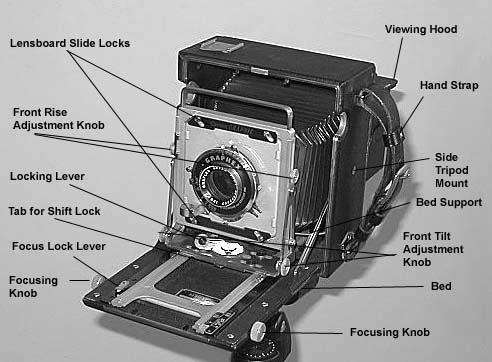 |
Unlike a wooden folder, the Crown Graphic does not collapse on itself in a series of movements. Instead, the front standard slides back into the camera body, which is, essentially, a protective box. The bed then folds up to form a cover for the body. This makes it quick and easy to open the camera and set it up.
A great advantage of the Crown Graphic and other press camera designs is that they can close with a compact lens mounted on the camera. To give you an idea of what might fit in a closed Crown Graphic, I have been able to close mine with the following lenses installed: 125mm f/5.6 Fujinon W (a great option for a "normal" lens on this camera), 135mm f/4.5 Graflex Optar (the lens that came with the camera), 210mm f/6.8 Caltar II-E, and even a 300mm f/9.0 Nikkor-M (closing the camera with this lens mounted is a little tight). Many other lenses would fit just as well.
My camera has two ¼-20 tripod sockets. One is where you would expect it, on the bottom of the camera. The other is on the left side. The bottom socket is for horizontal photographs. The side socket is used to make vertical photographs without having to flip the tripod head on its side. The side socket is located under the leather hand strap, so you have to make sure that the strap is loose enough to fit over your tripod head. I attached two quick release plates to my camera, so it easily and quickly snaps into place on my tripod head regardless of the orientation I select to compose a photograph.
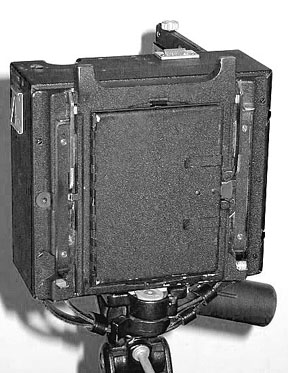 |
To open the cover/camera bed, find a raised bump under the leatherette on the top of the camera's left side. Pressing the button releases the bed. Although the button is hard to find initially, once you know where it is, it is easy to locate by feel. When the bed is released, push it down until it locks into place. You will know it is locked when it snaps into place with a loud click. To extend the front standard, loosen the locking lever at the standard's base by rotating it until it points directly away from the back of the camera. Then pull the lever (and thus the standard) forward. To lock the standard in place, just move the locking lever to either side until it can move no further.
FOCUSING
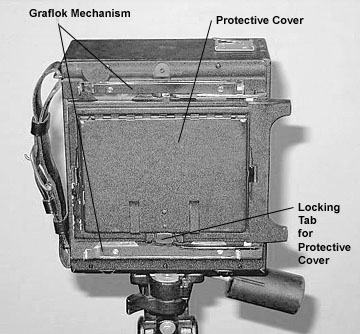 |
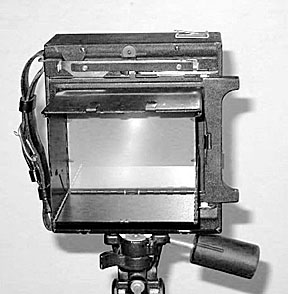 |
To access the groundglass, press on the silver tab at the bottom center of the Graflok back. The all-metal protective cover pops open to form a viewing hood. The Crown Graphic has a nice groundglass/Fresnel lens combination. The glass is evenly illuminated and focusing is fairly easy, even when using an extreme wide angle lens like the 75mm f/4.5 Grandagon-N. The groundglass does not include a grid, or indicators for smaller formats, such as 6x7, 6x9, etc.
The viewing hood limits the type of loupe you can use because it does not allow you to place your eye close enough to use a standard loupe. A loupe with a long barrel, like the Toyo 3.6X loupe works well.
Focusing is easy. There are two knurled focusing knobs on both sides of the far end of the bed, and a locking lever on the front right end of the bed. You focus by rotating the knobs back and forth until you are satisfied that the image is sharp. Use the locking lever to make sure that you do not knock the image out of focus.
LENSES
Crown Graphics are flexible enough to use a wide range of lenses appropriate for landscape photography. The bellows has plenty of extension, approximately 12.5 inches, to accommodate any non-telephoto lens up to 300mm.
The best lens candidates for use with a Crown Graphic are small and light, like the classic press camera lenses. Good examples are: The Kodak Ektars, Graflex Optars, Wollensack Raptars, and Schneider Xenar lenses originally sold for use with these cameras, modern Tessar-type designs like the Nikkor M series and Schneider Xenars, triplets like the Rodenstock Geronar or Caltar II-E series, process-type lenses like the Schneider G-Claron, Fujinon A series and Rodenstock APO-Ronar, Schneider Symmar convertible lenses, and classic wide field designs like the Schneider Angulons, Wide Field Congos and Wide Field Ektars.
Reportedly, you can use lenses as wide as 65mm with a Crown Graphic and a flat lens board. I have not confirmed this, but believe that it is true, given that the focusing rails extend inside the camera body, and the bellows compresses very tightly. I have used my Crown with a lens nearly that wide, a 75mm f/4.5 Rodenstock Grandagon-N, and found it a good combination. The 75mm lens requires you to use the drop bed feature (see below). A 125mm does not. I think that a small 90mm, such as an old Schneider Angulon or a Wide Field Congo would be a good wide-angle option with this camera. A Kodak 100mm Wide Field Ektar is another excellent alternative.
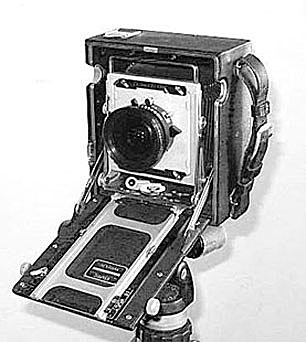 |
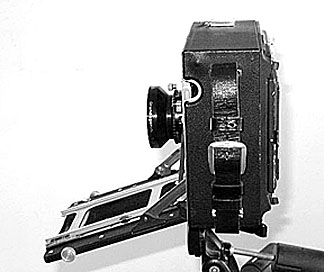 |
The big wide angles with big image circles are not necessarily good fits with the Crown Graphic. My 90mm f/4.5 Grandagon-N is too big and heavy for this camera. The rear element barely fits inside the lensboard opening, and it makes the camera fairly front heavy. If you want to buy a modern wide angle lens for this camera, the lighter, smaller, and less expensive versions of the current Rodenstock Grandagon-N, Schneider Super Angulon, Fujinon SW, and Nikkor SW lines are better-sized for use on a Crown Graphic. The camera does not allow much in the way of movements with lenses this wide. For example, very little movement is possible with my 75mm lens because the front standard has to be set so far back on the focusing rails that the bed supports and the camera body interfere with most movements, including front rise.
Wide-angle lenses require use of the drop bed feature, which drops the bed downward so that it will not intrude in the lens's field of view. To use the drop bed, press down on the two bed supports while also applying downward pressure on the bed. The bed drops into place. (This is much easier to do than to describe.) Once the bed is in place, you apply a corrective back tilt to the front standard to bring the lens into alignment with the camera back (see below), and possibly some front rise as well.
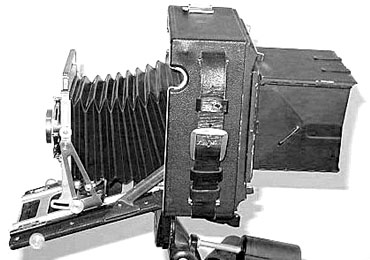 |
MOVEMENTS
The Crown Graphic is a press camera. It does not feature extensive movements.
Front Rise: The easiest and most intuitive of the movements to use is the front rise - Just loosen the two knobs on either side of the front standard, raise the standard, and tighten the knobs.
Front Tilt: The front standard does not tilt forward. It does, however, tilt backward. This might seem odd, but is easily explainable. The back tilt works in conjunction with the drop bed (see above). After the bed is dropped, the formerly vertical front standard will point downward. In effect, this is a severe front tilt combined with a front fall. To correct this situation, apply the full amount of back tilt, which brings the front standard into alignment with the camera back. Application of some front rise might also be appropriate at this point.
Even though the front standard does not tilt forward, it is possible to achieve a front tilt by combining two movements. First, apply the drop bed. Next, apply the back tilt, but not all the way back. Stop tilting back when your lens achieves the desired amount of forward tilt.
Front Fall: Similarly, it is possible to apply front fall by dropping the bed, applying front tilt backward to align the front standard with the back (thereby applying the maximum amount of front fall), and raising the front standard until you reach the desired amount of front "fall."
Front Shift: There is a small amount of front shift. To shift, release the locking lever that you use to extend the front lensboard from inside the camera body. Press down on the small tab just below the lever. Then slide the standard to the left or the right. The amount of front shift is even more limited than normal when using short focal length lenses. This is because the bed supports interfere with the full range of shift movements. With longer focal length lenses and more extension, there is no interference, and more shift is available. In use, having to unlock the front standard to apply a shift often causes the front standard to move backward or forward a bit, throwing the image out of focus and requiring you to refocus the image.
Front Swing: There is no front swing.
Back Movements: The Crown Graphic was designed without any back movements. However, it is also possible to achieve a sort of back tilt by combining some of the front movements with an adjustment of your tripod head. First, tilt your tripod head back slightly. The degree that you tilt the head back will be based on your experience, because you won't be able to see the effect of your movements for a little while. Next, drop the bed. Then, apply any necessary front rise. Finally, tilt the front standard backward until it is where you want it. Once you have completed all of these movements, you will be able to see the results of your "back tilt" and can make any fine adjustments.
Of course, all of the movements described above assume that the camera is mounted on the tripod for a horizontal composition. The available movements are severely impacted when you turn the camera on its side to make a vertical photograph: Back tilt becomes left swing. The drop bed becomes a sort of right swing, or a right shift if it is combined with back tilt. The rise becomes a left shift. Front rise and fall are minimal in this orientation, because the meager shift movement is now in the vertical orientation. This is a significant drawback if you are accustomed to using front movements in the field.
A number of creative photgaphers have devised methods to augment the front movements on a Crown Graphic. Here are two examples: Example 1, Example 2. (These examples call for physical modifications to allow for front and back tilt, or partial disassembly of the camera to reverse the front standard so that it tilts forward instead of backward. Of course, the latter option limits you to lenses that do not require use of the drop bed because you will no longer be able to correct the front tilt.) Another similar source is the article "Make Your Press Camera Behave Like a Field Camera" by Bertram W. Miller in Photo Techniques Magazine, Vol. 17, No. 4 (1996).
LENSBOARDS
Crown Graphics use dedicated lensboards that also fit on the Speed Graphic, Super Graphic, and Super Speed Graphic. They are available used from a variety of sources. In addition, Midwest Photo Exchange manufactures these lensboards new from the original dies. The store inventories lensboards with holes predrilled for Copal No. 0 and Copal No. 1 shutters, or with a pilot hole that allows you to drill the board to any size you desire.
The lens mounts by placing it onto the front standard and moving two slide locks, one on the top, the other on the bottom, to hold the board in place.
THE CAMERA BACK
As noted above, the camera back is not reversible. This is a major inconvenience in the field but, on the bright side, it does eliminate one source of dust entering the camera.
The back is a removable international standard Graflok style back. It should accept all roll film backs designed to the international standard. It also accepts standard two-sided sheet film holders and Grafmatic holders. My camera accepts my Polaroid 545 holder, Calumet C2 roll film holder, and sheet film holders without any problems.
IN THE FIELD
The Crown Graphic is light and easy to carry. It weighs only 4.8 pounds, including a 135mm Graflex Optar lens (but excluding the rangefinder). It is very quick to set up. Opening the bed, locking it into place, extending the front standard, and popping open the groundglass cover takes just a few seconds. The camera is quickly ready to compose a photograph. I use the Crown Graphic in conjunction with a Manfrotto 3030 head and 3021 tripod legs. This common combination is a good fit with the Crown. A tripod head with built-in levels would be useful, since neither the body, nor the front standard feature bubble levels. It would also be a simple matter to add levels to the camera body.
Using movements with the Crown Graphic is cumbersome, as is readily apparent from the discussion above. For me, the camera's most useful movement is the front rise (for horizontal compositions). There is such a minimal amount of front shift that I don't try to use that feature any more. Similarly, I do not like to use the drop bed/backward tilt combination to accomplish front tilt. The drop bed works great with wide-angle lenses.
The lack of movements is both troubling and liberating. If you are used to working with a monorail camera that allows full movements on the front and back standards, most of the movements you regularly employ are either not available on the Crown, or difficult to implement. This is a real disadvantage of the Crown Graphic when used as a field camera. Some photos are hard, and at times impossible, to make without these movements. For example, landscape photographers may want to apply some back tilt to emphasize an object in the foreground. Or, they may want to use significant front rise in a vertical composition that includes trees. These are tasks that the Crown Graphic was not designed to handle.
On the other hand, it is refreshing to set up the camera, compose, and make a photograph with a minimum of fuss and concern about image controls. If you are an experienced large format photographer accustomed to using a variety of movements, once you become accustomed to this manner of 4x5 photography, it can be quite enjoyable. The Crown is ready to go on a moment's notice, and is so easy to use. After all, isn't this is the essence of the Crown Graphic and its ilk, even when using the camera on a tripod instead of handheld? For those photographers who have not yet used a camera with extensive movements, they will not miss them. Instead they can concentrate on all of the Crown's fine attributes. If they find that they want a camera with more movements, there seems to be a ready market for used Crown Graphics.
One simple modification will simplify f/stop selection for depth of field purposes - The addition of a millimeter scale to the bed. This will be especially helpful given the camera's restricted front movements.
PRICE AND AVAILABILITY
This is one of the great features of the Crown Graphic: There are plenty of them available at very reasonable prices. They go up for auction regularly on EBay, and are commonly available in good shape with a lens for under $400.00 from used camera dealers. At auction, they can go for much lower. If you buy carefully, it is very possible to obtain a camera that you can sell for just about what you paid for it if you decide that either a Crown Graphic or large format photography is not for you.
PROS AND CONS
There is much to like about the Crown Graphic as a field camera:
There are also some significant drawbacks to the Crown Graphic as a field camera:
The Crown was not designed as a field camera, so it can hardly be faulted for its lack of some field camera features. Therefore, this review should not be interpreted as strong criticism of the Crown. It is not. The Crown Graphic is not a field camera, yet I am forcing it to be one. I can hardly complain that some of its attributes are not ideal for this task. Nevertheless, the camera's disadvantages as a field camera must be discussed so potential users are aware of them and recognize them in advance.
ALTERNATIVE CHOICES
Crown Graphics are not the only press cameras available at low prices that can be used as field cameras. A good alternative is the Speed Graphic, which has slightly more bellows extension than the Crown, and includes a built-in focal plane shutter with speeds up to 1/1000 second. The Speed Graphic has a slightly bigger wooden body, and is reputedly not quite as wide-angle friendly as the Crown. The Speed's integral focal plane shutter makes it possible to use barrel lenses, which are readily available on the used market at lower prices than lenses mounted on shutters. Another excellent candidate is the Super Graphic, which features a 360 degree revolving back, plus extensive front movements, including front tilt forward and front swing. The closely related Super Speed Graphic features a revolving back, and a 135mm f/4.5 Graflex Optar lens (manufactured by Rodenstock) mounted on a Graflex 1000 shutter. This was a between-the-lens shutter with a 1/1000 second top speed! (The Super and the Super Speed Graphics both have metal bodies.) Other good press camera candidates for field use include the Busch Pressman, Meridian 45A, Meridian 45B, and the MPP.
CONCLUSION
If you don't own a field camera and want to add one to your collection at very low cost, the Crown Graphic is a viable alternative. However, you pay for that low cost in the loss of some of the very useful field camera movements that do so much to distinguish large format cameras from their smaller brethren. The good news here is that having the full range of movements is less important for landscape photography, the traditional fair of the field camera, than it is in other aspects of photography (like architectural photography, where movements are indispensable).
What you get with a Crown Graphic is a robust camera that is easy to pack, light in weight, very quick to set up and put into action, and fun to use.
All photographs for this article are © 2004 David C. Karp. They were taken hand held with an Olympus C-900 Zoom 1.3 megapixel digital point and shoot camera.